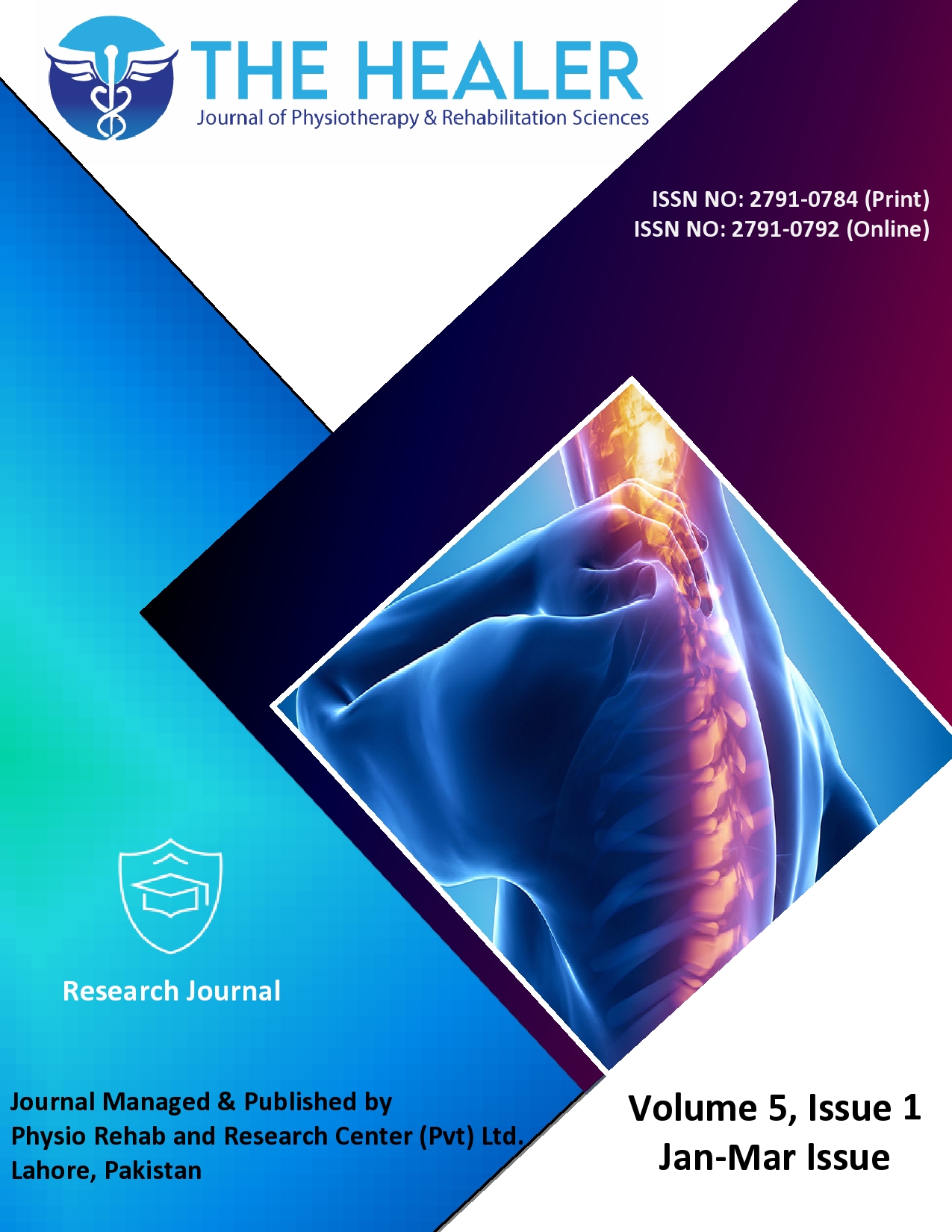Impact of Pelvic Crossed Syndrome on Primary Dysmenorrhea and Physical Activity
DOI:
https://doi.org/10.55735/k85n2k82Keywords:
Lower cross syndrome , Painful menstrual periods , Pelvic cross syndrome , Physical activity , Primary dysmenorrheaAbstract
Background: Pelvic cross syndrome is characterized by muscle imbalances around the pelvis, resulting in changes in pelvic alignment and movement patterns. Engaging in regular physical activity has been linked to numerous benefits, including reduced menstrual pain severity and improved overall fitness and mobility. Objective: To determine the impact of pelvic cross syndrome on primary dysmenorrhea and physical activity. Methodology: This comparative cross-sectional analytical design was conducted at the Shalamar School of Allied Health Sciences, Lahore, over a period of six months. A total of 60 females, aged between 18 and 25 years, were selected into two groups: those with pelvic cross syndrome with and without primary dysmenorrhea. Pre-diagnosed participants were selected who were nulliparous, unmarried, and free of chronic illnesses or recent surgeries. Primary dysmenorrhea was diagnosed using a visual analogue scale, with recurrent lower abdominal cramps. Participants with secondary dysmenorrhea, chronic abdominal pain, ovarian cysts, irritable bowel syndrome, or recent surgeries were excluded from the study. Participants were examined for muscle tightness and weakness using 5-minute warm-up, followed by assessments for pelvic cross syndrome prevalence through the manual muscle testing. Primary dysmenorrhea severity was assessed using the WaLIDD score. Participants completed the International Physical Activity Questionnaire to assess their physical activity status. The qualitative data were assessed through frequencies and percentages. Results: The study found that 58.3% of students had pelvic cross syndrome, with 42.9% of those also experiencing dysmenorrhea. Among those with both dysmenorrhea and this syndrome, 60% reported severe pain, while 90% of those with pelvic cross syndrome but without dysmenorrhea had low pain. Pelvic tilt was found in 46.7% of participants, and physical activity levels were low in 73% of those with both conditions, while 55% of individuals without either condition reported high physical activity. Conclusion: This concluded that 58.3% of young students developed pelvic cross syndrome, with 42.9% also experiencing dysmenorrhea. Younger age, lower BMI, and muscle imbalances were linked to both pelvic cross syndrome and primary dysmenorrhea, leading to higher pain and lower physical activity. In contrast, those with pelvic cross syndrome but no primary dysmenorrhea reported less pain and higher physical activity.
Downloads
References
1. Janda V. Muscles in the pathogenesis of musculoskeletal disorders. Oxford Textbook of Musculoskeletal Medicine 2015: 121-125.
https://doi.org/10.1093/med/9780199674107.003.0012
2. Yaseen S, Asif N, Urooj A, Raza MAA. Relationship Between Pelvic Cross Syndrome, Gait, and Balance Impairments: PCS and Gait/Balance Impairments. Journal of Health and Rehabilitation Research 2024; 4(3).
https://doi.org/10.61919/jhrr.v4i3.1431
3. Morrison P. Musculoskeletal conditions related to pelvic floor muscle overactivity. The overactive pelvic floor 2016: 91-111.
https://doi.org/10.1007/978-3-319-22150-2_7
4. Kim B, Yim J. Core stability and hip exercises improve physical function and activity in patients with non-specific low back pain: a randomized controlled trial. The Tohoku Journal of Experimental Medicine 2020; 251(3): 193-206.
https://doi.org/10.1620/tjem.251.193
5. Prather H, Cheng A, Steger-May K, Maheshwari V, Van Dillen L. Hip and lumbar spine physical examination findings in people presenting with low back pain, with or without lower extremity pain. Journal of Orthopaedic & Sports Physical Therapy 2017; 47(3): 163-72.
https://doi.org/10.2519/jospt.2017.6567
6. Baker PK. Musculoskeletal origins of chronic pelvic pain: diagnosis and treatment. Obstetrics and Gynecology Clinics of North America 1993; 20(4): 719-42.
7. Serrano-Imedio A, Calvo-Lobo C, Casañas-Martin C, Garrido-Marin A, Pecos-Martin D. Myofascial Pain Syndrome in Women with Primary Dysmenorrhea: A Case-Control Study. Diagnostics 2022; 12(11): 2723.
https://doi.org/10.3390/diagnostics12112723
8. Molins-Cubero S, Rodríguez-Blanco C, Oliva-Pascual-Vaca Á, et al. Changes in pain perception after pelvis manipulation in women with primary dysmenorrhea: a randomized controlled trial. Pain Medicine 2014; 15(9): 1455-63.
https://doi.org/10.1111/pme.12404
9. Pradeep S, Heggannavar A, Metgud S. Effect of sciatic nerve neurodynamic sustained natural apophyseal glides on individuals with pelvic crossed syndrome: A randomized controlled trial. Indian Journal of Physical Therapy and Research 2020; 2(1): 35-40.
https://doi.org/10.4103/ijptr.ijptr_40_19
10. de Las Mercedes Villa Rosero CY, Mazin SC, Nogueira AA, et al. Prevalence of chronic pelvic pain and primary dysmenorrhea in women of reproductive age in Ecuador. BMC Women’s Health 2022; 22(1): 363.
https://doi.org/10.1186/s12905-022-01948-y
11. Blanco-Diaz M, Vielva-Gomez A, Legasa-Susperregui M, et al. Exploring Pelvic Symptom Dynamics in Relation to the Menstrual Cycle: Implications for Clinical Assessment and Management. Journal of Personalized Medicine 2024; 14(3): 239.
https://doi.org/10.3390/jpm14030239
12. Ferries-Rowe E, Corey E, Archer JS. Primary dysmenorrhea: diagnosis and therapy. Obstetrics & Gynecology 2020; 136(5): 1047-58.
https://doi.org/10.1097/AOG.0000000000004096
13. Vincenzo De Sanctis M, Soliman A, Bernasconi S, et al. Primary dysmenorrhea in adolescents: prevalence, impact, and recent knowledge. Pediatric Endocrinology Reviews (PER) 2015; 13(2): 465-73.
14. Beiske A, Loge J, Rønningen A, Svensson E. Pain in Parkinson’s disease: prevalence and characteristics. Pain 2009; 141(1-2): 173-7.
https://doi.org/10.1016/j.pain.2008.12.004
15. Doga M, Bonadonna S, Gola M, Mazziotti G, Giustina A. Growth hormone deficiency in the adult. Pituitary 2006; 9(4): 305-311.
https://doi.org/10.1007/s11102-006-0410-y
16. Dai M, Bai M, Chen Y, Li J, Wan T, Jiang H. Application of Comprehensive Pelvic Floor Rehabilitation Therapy in Congestion Syndrome with Pelvic Oblique: A Case Report. Alternative Therapies in Health and Medicine 2024; 30(10): 59-65.
17. Giagio S. Musculoskeletal disorders, research quality, and pelvic floor health in sports: exploring current evidence and new perspectives. Amsdottorato 2024.
https://doi.org/10.48676/unibo/amsdottorato/11175
18. Fiani B, Sekhon M, Doan T, et al. Sacroiliac joint and pelvic dysfunction due to symphysiolysis in postpartum women. Cureus 2021; 13(10): e18619.
https://doi.org/10.7759/cureus.18619
19. Wójcik M, Jarząbek-Bielecka G, Merks P, et al. Visceral therapy and physical activity for selected dysfunctions, with particular emphasis on locomotive organ pain in pregnant women-Importance of reducing oxidative stress. Antioxidants 2022; 11(6): 1118.
https://doi.org/10.3390/antiox11061118
20. Ginis KAM, van der Ploeg HP, Foster C, et al. Participation of people living with disabilities in physical activity: a global perspective. The Lancet 2021; 398(10298): 443-55.
https://doi.org/10.1016/S0140-6736(21)01164-8
21. Filbay SR, Skou ST, Bullock GS, et al. Long-term quality of life, work limitation, physical activity, economic cost and disease burden following ACL and meniscal injury: a systematic review and meta-analysis for the OPTIKNEE consensus. British Journal of Sports Medicine 2022; 56(24): 1465-74.
https://doi.org/10.1136/bjsports-2022-105626
22. Ghali A, Lacombe V, Ravaiau C, et al. The relevance of pacing strategies in managing symptoms of post-COVID-19 syndrome. Journal of Translational Medicine 2023; 21(1): 375.
https://doi.org/10.1186/s12967-023-04229-w
23. Po-Ching Huang, Hung-Ching Wu, Ji-Kang Chen, et al. The mediating role of physical activity avoidance in the association between weight stigma and physical activity. Acta Psychologica 2025; 257: 105107
https://doi.org/10.1016/j.actpsy.2025.105107
24. Sima R-M, Sulea M, Radosa JC, et al. The prevalence, management and impact of dysmenorrhea on medical students’ lives - A multicenter study. Healthcare 2022; 10(1): 157.
https://doi.org/10.3390/healthcare10010157
25. Franco-Antonio C, Santano-Mogena E, Cordovilla-Guardia S. Dysmenorrhea, Premenstrual Syndrome, and Lifestyle Habits in Young University Students in Spain: A Cross-Sectional Study. Journal of Nursing Research 2025; 33(1): e374.
https://doi.org/10.1097/jnr.0000000000000657
26. Ghorat F, Mosavat SH, Hadigheh S, et al. Prevalence of complementary and alternative medicine use and its associated factors among Iranian diabetic patients: a cross-sectional study. Current Therapeutic Research 2024; 100: 100746.
https://doi.org/10.1016/j.curtheres.2024.100746
27. Alorani OI, Erkir S, Rababa’h SY, et al. English Language Teachers’ Perspectives on Technological Applications Used for Students With Disabilities. Journal of Language Teaching and Research 2025; 16(1): 168-79.
https://doi.org/10.17507/jltr.1601.18
28. Tosun B, Uysal N. Examination of oral health quality of life and patient satisfaction in removable denture wearers with OHIP-14 scale and visual analog scale: a cross-sectional study. BMC Oral Health 2024; 24(1): 1353.
https://doi.org/10.1186/s12903-024-05124-6
29. Rejeki S, Pranata S, Yanto A, Wahyuni S. Complementary therapies and factors related to dysmenorrhoea in adolescents: a bibliometric analysis. Scripta Medica 2024; 55(1): 85-95.

Downloads
Published
License
Copyright (c) 2025 The Healer Journal of Physiotherapy and Rehabilitation Sciences

This work is licensed under a Creative Commons Attribution 4.0 International License.














